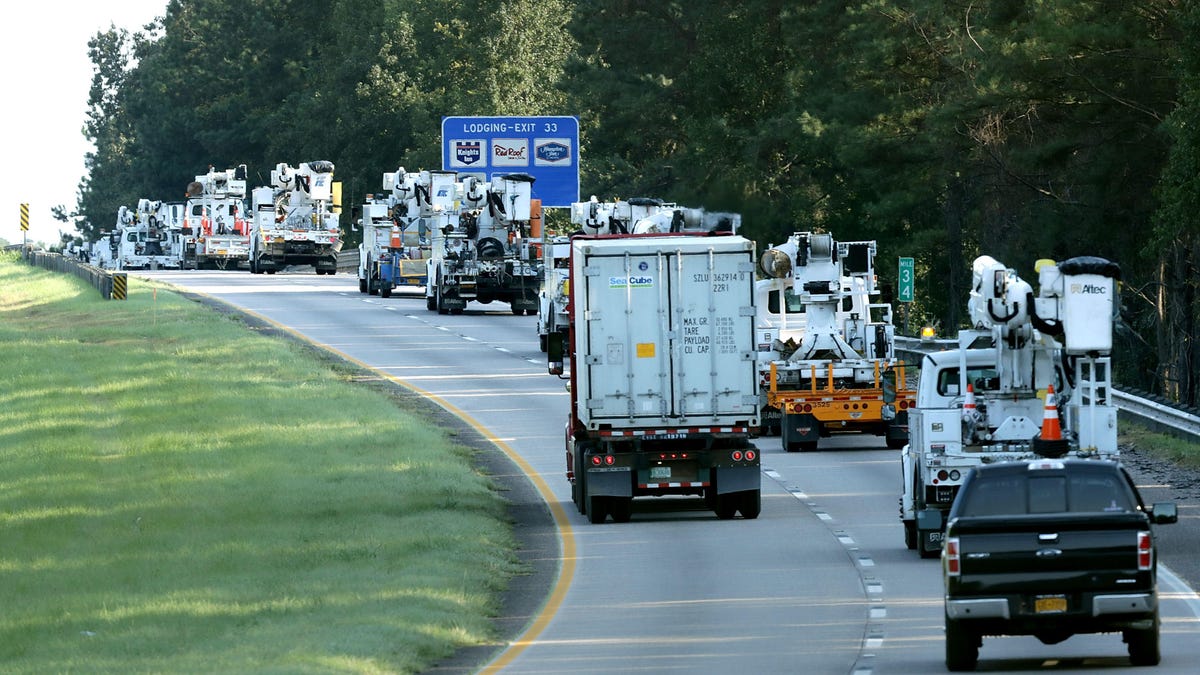Will cell networks stand up to Irma?
Despite unprecedented flooding in the wake of Hurricane Harvey, millions were still able to use their cellphones. Will Hurricane Irma victims be as lucky?

Wireless communications networks will be tested once again as the fiercest storm in two decades hits Florida this weekend.
Just two weeks after Hurricane Harvey barreled into the Gulf Coast of Texas, residents in Florida are bracing for Hurricane Irma, the biggest storm the state has faced in more than 20 years.
Cellular service held up better during Harvey than in past storms, which is surprising given the scope and size of the disaster. But it's unclear if the networks will be able to stand up to the larger, and potentially more destructive, Irma.
Irma has already left a wake of destruction as it churns through the Caribbean, where it flattened 90 percent of structures on the island of Barbuda. It's expected to hit the Florida Keys early Sunday morning. With winds in excess of 150 miles per hour and a diameter that stretches across the entire state, the storm "is expected to cause major and life-threatening impacts from coast to coast," said Florida Gov. Rick Scott.
It's increasingly critical that cell service works during times of disaster. Fewer people have landlines, and they rely on a smartphone for many things beyond a simple phone call. When disaster strikes, people turn to their phones to call for help, reach loved ones and get vital information.
As a result, wireless carriers have taken seriously the need to ensure the reliability of their networks. From the terrorist attacks on Sept. 11, 2001, to Hurricane Katrina in 2005 and the most recent hurricane in Texas, it appears carriers have learned important lessons that have improved resiliency of the nation's wireless infrastructure. Irma could be the biggest challenge.
"When you look at what happened on Barbuda, you simply can't build a hardened structure that will withstand 185 mph," said Jamie Barnett, a partner at law firm Venable and a former chief of the Federal Communications Commission's Public Safety and Homeland Security Bureau.
A message reading "You Don't Scare Us Irma" is written on plywood being used to cover the windows of a building as people prepare for the arrival of Hurricane Irma on September 8, 2017 in Miami Beach, Florida.
Preparations
The nation's four largest wireless carriers say they're working to make sure their customers stay connected during and after the storm.
They've topped off fuel on generators at cell sites and switching stations, positioned backup power and fuel closer to cell sites to make sure they're available immediately following the storm, and mobilized armies of temporary cell towers on wheels, also known as COWs.
They say their infrastructure is built to withstand wind and flooding from category 4 and 5 hurricanes, thanks to local building codes. This is important, given the fierce winds and the predicted size of the storm.
But more than the wind, it's access to commercial power that often causes outages during and after big disasters.
"While we do occasionally have equipment damaged on towers due to high winds (generally antennas) it is extremely rare for a tower to have structural failure," said Sprint spokeswoman Adrienne Norton.
Barnett said wireless carriers have made significant improvements to their networks to ensure that they have backup power available to cell sites and switching locations in case commercial power is lost.
Verizon spokeswoman Karen Schulz said virtually all Verizon's cell sites throughout Florida and other states that could be affected by Irma have battery and/or generator backups.
But consumer advocates, like Regina Costa, the chair of the telecommunications committee of the National Association of State Utility Advocates, have said it's not enough for operators to simply say they're prepared. Costa would like to see the FCC make battery and generator backup to cell sites a requirement, something the industry has resisted.
"We can't simply take the word of the wireless carriers at face value when they say they're adequately prepared," Costa said. "We must verify."
What to expect
It's too early to say how the wireless networks will fare in the wake of Irma. But performance over the years has shown improvements in resiliency. Hurricane Katrina knocked out more than 1,000 cellular sites when it hit New Orleans in 2005, according to the FCC.
When Superstorm Sandy hit the eastern US in 2012, roughly a quarter of the wireless networks in the affected area were down. By contrast, just 4 percent of the 7,804 cell sites in Harvey's path experienced outages during the storm, according to the FCC. That's less than 400 cell towers.
Experts caution that every storm is different. Most of the devastation from Harvey came from heavy rains and flooding. Irma's damage is expected to come from winds and flooding from storm surge. Barnett said that people, especially those living in areas where Irma is likely to make landfall, should prepare for the worst. Even though carriers made out fairly well in Harvey, in the region where the storm first hit the Gulf Coast of Texas, virtually all cell service was knocked out during and immediately following the storm.
"This is a large and destructive storm," Barnett said. "It has the potential to break the entire peninsula, and we will likely see significant impacts to communication networks throughout the entire state."
For more information on how to prepare for hurricanes and other disasters, check out this Ask Maggie column and these other CNET stories. AT&T is also offering live updates on a blog.
The Smartest Stuff: Innovators are thinking up new ways to make you, and the things around you, smarter.
CNET en Español: Get all your tech news and reviews in Spanish.

